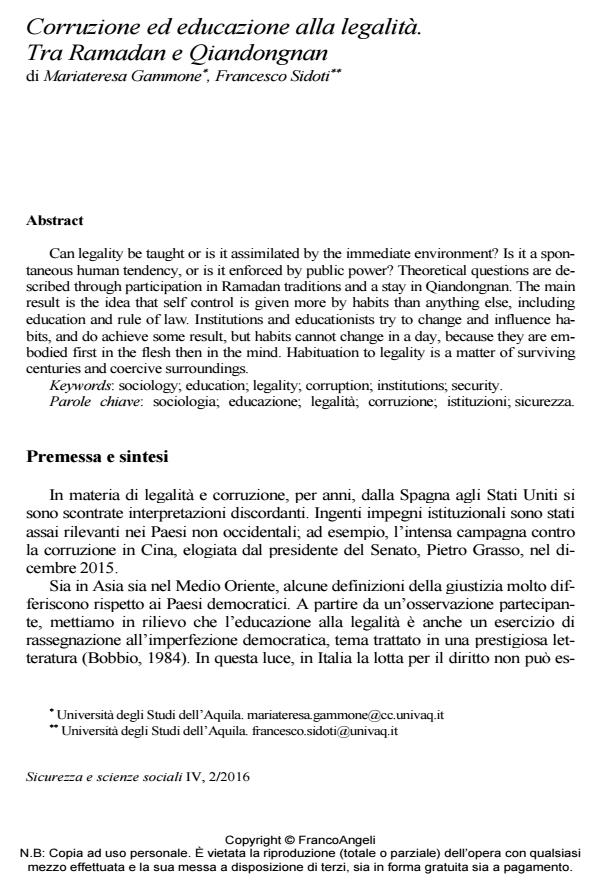Corruzione ed educazione alla legalità. Tra Ramadan e Qiandongnan
Titolo Rivista SICUREZZA E SCIENZE SOCIALI
Autori/Curatori Mariateresa Gammone, Francesco Sidoti
Anno di pubblicazione 2016 Fascicolo 2016/2
Lingua Italiano Numero pagine 16 P. 63-78 Dimensione file 589 KB
DOI 10.3280/SISS2016-002005
Il DOI è il codice a barre della proprietà intellettuale: per saperne di più
clicca qui
Qui sotto puoi vedere in anteprima la prima pagina di questo articolo.
Se questo articolo ti interessa, lo puoi acquistare (e scaricare in formato pdf) seguendo le facili indicazioni per acquistare il download credit. Acquista Download Credits per scaricare questo Articolo in formato PDF

FrancoAngeli è membro della Publishers International Linking Association, Inc (PILA)associazione indipendente e non profit per facilitare (attraverso i servizi tecnologici implementati da CrossRef.org) l’accesso degli studiosi ai contenuti digitali nelle pubblicazioni professionali e scientifiche
Can legality be taught or is it assimilated by the immediate environment? Is it a spontaneous human tendency, or is it enforced by public power? Theoretical questions are described through participation in Ramadan traditions and a stay in Qiandongnan. The main result is the idea that self control is given more by habits than anything else, including education and rule of law. Institutions and educationists try to change and influence habits, and do achieve some result, but habits cannot change in a day, because they are embodied first in the flesh then in the mind. Habituation to legality is a matter of surviving centuries and coercive surroundings.
Parole chiave:Sociologia; educazione; legalità; corruzione; istituzioni; sicurezza.
- Aguirre M. (2000). China. Capitalismo Rojo. Los desafios del viaje a la riqueza. Barcelona: Flor del vento.
- Anders G. (1979). Nach “Holocaust”. München: C.H. Beck Verlag.
- Berggruen N., Gardels N. (2012). Intelligent Governance for the 21st Century: A Middle Way between West and East. London: Polity.
- Bobbio N. (1984). Il futuro della democrazia. Torino: Einaudi.
- Bohn R., Epkenhns M. (Hrsg.) (2015). Garnisonsstädte im 19. und 20. Jahrhundert. Gütersloh: Verlag für Regionalgeschichte.
- Brooks D. (2012). The Social Animal: The Hidden Sources of Love, Character, and Achievement. New York: Random House.
- Crozier M., Huntington S. P., Watanuki J. (1975). The Crisis of Democracy: Report on the Governability of Democracies to the Trilateral Commission. New York: New York University Press.
- dalla Chiesa N. (2014) Manifesto dell’Antimafia. Torino: Einaudi.
- Duhigg C. (2012). The Power of Habit: Why We Do What We Do in Life and Business. New York: Random House.
- Gammone M. (2013a). Corruption in classical European criminology, 1876-1914. Beijing: International Forum on Crime and Criminal Law in the Global Era, 19-32.
- Gammone M. (2013b). The European Frontier in Our Global Village. Security Dimensions, 2: 20-29.
- Löwith K. (1949). Meaning in History: The Theological Implications of the Philosophy of History. Chicago: University of Chicago Press.
- Lukács G. (1920). Die Theorie des Romans. Ein geschichtsphilosophischer Versuch über die Formen der großen Epik. Berlin: Cassirer.
- Mazzarino S. (1959). La fine del mondo antico. Milano: Garzanti.
- Plass H. (Hrsg.) (2015). Klasse Geschichte Bewusstsein. Was bleibt von Georg Lukács’ Theorie? Berlin: Verbrecher Verlag.
- Russakoff D. (2015). The Prize: Who’s in Charge of America’s Schools? New York: Houghton Mifflin.
- Sidoti F. (1980). La Cina è vicina. Queste istituzioni, 36.
- Sidoti F. (1993). I giudici nel sistema dei controlli. La magistratura. Organo dell’Associazione nazionale magistrati. Testo disponibile al sito: http://www.associazionemagistrati.it/rivista-lamagistratura.
- Sidoti F. (1994). La justice juvenile et la mafia. In: Gazeau J.-F., Peyre V., La justice réparatrice et les jeunes. Vaucresson: Reseau Internationale de Criminologie Juvenile.
- Sidoti F. (1996). Istituzioni e criminalità. Padova: Cedam. Sidoti F. (1997). Anti Formalistic Reasonings on Corruption: Yesterday and Tomorrow. 서유럽에대한 연구의 잡지. Seul: Hankuk University for Foreign Studies.
- Sidoti F. (2003). Le sfide dell’Asia. Modelli educativi a confronto. Rimini: Il Cerchio (in collaborazione con G. Tribuzio).
- Sidoti F. (2012). Il crimine all’italiana. Una tradizione realista, garantista, mite. Milano: Guerini.
- Tamanaha B. Z. (2004). On the Rule of Law: History, Politics, Theory. Cambridge: Cambridge University Press.
- Touraine A. (2013). La fin des sociétés. Paris: Seuil.
Mariateresa Gammone, Francesco Sidoti, Corruzione ed educazione alla legalità. Tra Ramadan e Qiandongnan in "SICUREZZA E SCIENZE SOCIALI" 2/2016, pp 63-78, DOI: 10.3280/SISS2016-002005